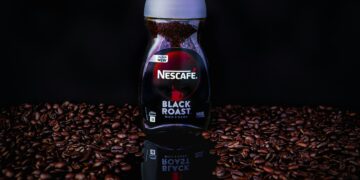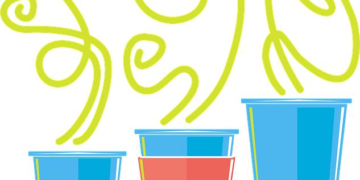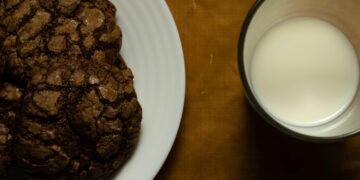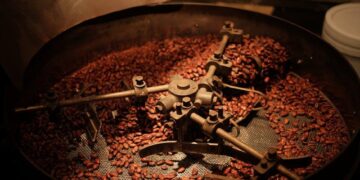Table of Contents
Introduction: The Anatomy of a Failed Coffee Run
The fluorescent lights of the minimalist coffee shop seemed to amplify the silence.
It was a place I’d found after a quick search for “best coffee near me,” a spot with stellar reviews and photos of latte art that looked like museum pieces.
As a strategist, I’m paid to deconstruct complex systems, to find patterns and pathways where others see chaos.
Yet, standing before a cryptic menu of single-origin names and unfamiliar terms, I felt a rising sense of panic.
My turn came.
The barista, a model of serene coolness, waited.
In a moment of desperation, I fell back on a familiar name.
“I’ll have a large caramel macchiato, please.”
The barista’s expression didn’t change, but a subtle tension entered the air.
A few minutes later, a small, ceramic cup appeared on the counter.
Inside was a tiny, intense-looking shot of espresso with a dollop of foam on top.1
There was no caramel, no tall cup of milky comfort.
This was a
traditional macchiato—espresso “marked” with foam—not the inverted, caramel-drizzled latte I knew from Starbucks.3
The gulf between my expectation and the reality in that tiny cup was vast and humiliating.
I had used the wrong language, exposed myself as an outsider, and failed the unspoken test of this specialty coffee sanctuary.
The experience was a classic case of what happens when two different dialects collide; the globally recognized but non-standard lingo of major chains versus the traditional, purist lexicon of independent cafes.1
This “Lingo Gap” is the source of immense social friction, creating anxiety for customers and frustration for baristas who field the same confusing questions day after day.5
That failure became a professional obsession.
I realized the problem wasn’t my ignorance, but my approach.
I was trying to navigate a complex, nuanced system with a completely inadequate map.
The world of specialty coffee wasn’t chaotic; it was a system with its own language, geography, and tools.
My epiphany was that I could apply the same systems thinking I use in my work to decode it.
I needed to build a better map, a better strategy.
This guide is the result of that effort.
It is built on a new paradigm for navigating the coffee world: The Coffee Navigator’s Toolkit. This framework is designed to transform anyone from a state of ordering anxiety to one of confident exploration.
The toolkit consists of three essential components, each addressing a critical point of failure in the journey to a great cup of coffee:
- The Lexicon: To master the language of the cafe and order with precision.
- The Compass: To master the art of discovery and find the best independent shops.
- The Accelerator: To master the transaction with tools that enhance your experience and support the local coffee ecosystem.
This is not just a list of tips.
It is a complete strategic framework for finding and enjoying great coffee, built to eliminate the anxiety of the unknown and replace it with the thrill of discovery.
Pillar I: The Lexicon — Mastering the Language of the Cafe
The first and most significant barrier to confidently ordering specialty coffee is the language itself.
The menu can appear as an intimidating list of foreign words, but this complexity is an illusion.
Nearly every beverage in a specialty coffee shop is a creative variation built from just four fundamental elements.
By understanding these building blocks, the entire menu ceases to be a list to be memorized and instead becomes a set of logical, understandable combinations.
The Four Building Blocks of Coffee
At the heart of the cafe menu are four core components.
Mastering these four variables is the key to decoding any drink order.
- Espresso: This is the foundation. It is not a type of bean but a brewing method. Finely ground coffee is packed tightly, and hot water is forced through it under extremely high pressure.6 The result is a small, concentrated shot of coffee with a strong, often acidic flavor and a layer of reddish-brown foam on top called
crema. The crema is crucial, adding texture and aromatic compounds to the shot.6 Espresso is the “quintessential Italian hero” upon which almost all other drinks are built.6 - Hot Water: The simplest modifier. It is used to dilute espresso, changing its intensity and volume without altering its fundamental flavor profile.
- Steamed Milk: Whole milk is heated with a steam wand, a process that breaks down lactose into simpler, sweeter-tasting sugars and creates a smooth, velvety texture. This is what gives lattes and other milk-based drinks their characteristic creaminess and natural sweetness, which should be pronounced enough to not require added sugar.6
- Microfoam: This is the star of drinks like the cappuccino. It’s created by injecting more air into the milk during the steaming process, resulting in a dense, stable, and finely textured foam that is silky, not bubbly.7 The quality of the microfoam is a hallmark of a skilled barista.
The Foundational Four & Their Cousins
With the four building blocks established, we can now construct the most common drinks on the menu.
Each is defined by the ratio of its components, which in turn dictates its flavor, texture, and overall experience.
- Espresso: Served on its own, typically as a single or double shot (one or two ounces, respectively). This is the most direct way to experience the flavor profile of the coffee beans themselves. It is a “tough cookie”—small but powerful—and not recommended for those who dislike strong coffee.1
- Americano: This drink is simply espresso diluted with hot water. Legend holds that it originated with American G.I.s in Italy during WWII who found straight espresso too intense and watered it down to mimic the drip coffee they were used to back home.6 It offers a full-bodied cup that retains the espresso’s natural aromas but in a larger, less overpowering format.2 A close relative is the
Long Black, popular in Australia and New Zealand, where the order of operations is reversed: espresso shots are poured over the hot water. This preserves the crema on top and often uses less water, resulting in a slightly stronger taste than an Americano.6 - Latte: The Italian for “coffee and milk,” a latte is the most milk-forward of the core espresso drinks. It consists of a shot or two of espresso topped with a significant amount of steamed milk (a common ratio is 1 part espresso to 3 or more parts milk) and finished with only a thin layer of microfoam.6 The result is a smooth, creamy, and approachable beverage, making it an excellent starting point for those new to espresso.7
- Cappuccino: A perfectly balanced classic, the cappuccino is defined by its equal-parts construction: roughly one-third espresso, one-third steamed milk, and one-third deep, luxurious microfoam.6 This generous “cap” of foam makes the drink feel remarkably light, almost like holding an empty cup.1 This is where modifiers become important. An order for a “dry” cappuccino requests more foam and less liquid milk, while a “wet” cappuccino is the opposite, leaning closer to a latte.1 Misunderstanding these terms is a frequent source of conflict, as seen in barista accounts of customers ordering a “bone dry” cappuccino and then being angry that it was all foam.4
- Flat White: Hailing from Australia, the flat white is an elegant, “no frills” drink for those who want a stronger coffee flavor than a latte but without the heavy foam of a cappuccino.6 It is typically made with a double shot of espresso and topped with steamed milk that has a very thin, “silky” layer of microfoam, creating a texture somewhere between a latte and a cappuccino but with a more pronounced coffee taste.7
Decoding the “Danger Zone” — Terms of Confusion
The greatest potential for ordering mishaps lies in a few key terms where the popular understanding, largely shaped by major chains, diverges sharply from the definitions used in specialty coffee shops.
Navigating this “danger zone” is critical to avoiding the macchiato mistake.
- The Macchiato Minefield: This is the most common point of confusion. A Starbucks “Caramel Macchiato” is, in its construction, an unstirred vanilla latte with caramel drizzle on top.1 A traditional Italian
Caffe Macchiato, however, is something entirely different. The word macchiato means “marked” or “stained” in Italian. The drink is a shot of espresso “marked” with a small dollop of milk foam.2 It is small, intense, and primarily about the espresso. Ordering a “macchiato” at an independent shop and expecting a large, sweet drink is the single most cited error that baristas encounter, immediately signaling a customer’s unfamiliarity with the standard lexicon.3 - The Mocha Misunderstanding: A Caffe Mocha is a straightforward and delicious combination: a latte with chocolate syrup or powder mixed in, often topped with whipped cream.2 It’s essentially a grown-up hot chocolate.1 Confusion can still arise, as one barista noted a customer who repeatedly insisted on ordering a “chocolate latte” and refused to accept that this is, by definition, a mocha.2 Knowing the correct term streamlines communication.
- Frappuccino vs. Blended Drink: “Frappuccino” is a trademarked brand name for Starbucks’ line of blended ice drinks.1 Ordering one at any other coffee shop is a faux pas akin to asking for a “McGriddle” at a local diner. The generic and correct term is a “frozen” or “blended” drink.
- Shots & Sizing: A frequent misconception among customers is that a larger drink size automatically means more caffeine. Caffeine content is determined by the number of espresso shots, not the total volume of milk or water.5 A small 6oz flat white and a large 16oz latte may both contain the exact same double shot of espresso and thus the same amount of caffeine. Baristas often express frustration when customers, concerned about caffeine, will reject a small, strong-tasting drink like a flat white in favor of a large, milky latte, not realizing the caffeine dose is identical.5 Furthermore, unlike major chains, the number of shots included in a small, medium, or large drink is not standardized across independent shops; it’s always acceptable to ask.4
By internalizing these definitions and distinctions, the coffee menu transforms from a source of anxiety into a field of possibilities.
The following table consolidates this information into a single, practical tool.
| Drink Name | Espresso (Shots) | Hot Water (Ratio) | Steamed Milk (Ratio) | Microfoam (Amount) | Tasting Notes / Experience |
| Espresso | 1-2 | None | None | Crema Only | Intense, concentrated coffee flavor. The purest expression of the bean. 7 |
| Americano | 1-2 | High (Dilutes) | None (Unless added) | None | Diluted espresso, similar to black coffee but with espresso’s unique flavor. 2 |
| Long Black | 2 | Medium (Less than Americano) | None (Unless added) | Crema Preserved | Stronger than an Americano, with a more noticeable crema as espresso is added last. 6 |
| Latte | 1-2 | None | High (e.g., 1:3+) | Thin Layer | Smooth, creamy, and milk-forward. A great introductory espresso drink. 6 |
| Cappuccino | 1-2 | None | Medium (Equal to foam) | Thick, Generous Layer | Balanced between coffee and milk, with a light, airy, foamy texture. 1 |
| Flat White | 2 | None | Medium | Very Thin, Silky Layer | Stronger coffee flavor than a latte, with a smooth, velvety texture and minimal foam. 7 |
| Macchiato | 1-2 | None | Dollop Only | A “Mark” of Foam | An espresso shot “stained” with a bit of foam. Strong and coffee-forward. 2 |
| Cortado | 1 | None | Low (Equal to espresso) | Minimal | A Spanish drink balancing espresso and steamed milk in equal parts. Strong but smooth. 5 |
| Mocha | 1-2 | None | High (Latte-style) | Optional Whipped Cream | A latte with added chocolate for a rich, sweet, and indulgent treat. 2 |
| Breve | 1-2 | None | High (Latte-style) | Creamy Foam | A latte made with steamed half-and-half instead of milk, creating a very rich, heavy drink. 2 |
Pillar II: The Compass — A Multi-Layered Strategy for Discovery
Once the language of coffee is no longer a barrier, the next challenge is discovery.
A simple search for “coffee near me” is a blunt instrument, ill-suited for the nuanced task of finding high-quality, independent coffee shops.
The modern challenge of discovery is not a lack of information, but a failure of curation.
A generic search yields overwhelming and poorly qualified results, mixing gas stations with world-class roasters.8
To overcome this, a sophisticated, tiered strategy is required—a compass that can guide you through the noise to the true gems.
This strategy involves moving from broad, uncurated tools to highly specialized, expert-driven resources.
Tier 1: The Standard Issue Map (Google/Apple Maps)
The default map application on any smartphone is the most convenient and universally accessible starting point.
Its primary strength is ubiquity.
However, for the specific task of finding specialty coffee, it has significant limitations.
A 4.5-star rating is an unreliable indicator of quality in this context; it doesn’t differentiate between a shop that serves passable coffee with friendly service and one that meticulously sources and roasts its own beans.
To improve the signal-to-noise ratio on these platforms, one must use more precise language.
Instead of a generic search for “coffee,” using more specific terms can yield far better results.
Searching for “specialty coffee,” “coffee roaster,” “pour over,” or “single origin” acts as a preliminary filter, surfacing businesses that at least use the language of the specialty industry.8
This is the first, most basic step in refining the search beyond the default.
Tier 2: The Curated Guides (Specialized Discovery Apps)
The shortcomings of generic maps created a market for a new generation of apps built by and for coffee lovers.
These platforms are not just selling data; they are selling a point of view and a promise of quality.
Their brand is their filter, and choosing the right one depends on your specific context and needs.
- Global & User-Driven (The Roasters App): Roasters positions itself as a “digital coffee journal” and boasts a massive, user-generated database of over 20,000 shops across 125 countries.9 Its key strength is its sheer breadth, making it an excellent tool for discovering “off the beaten path” cafes in nearly any corner of the world.10 Users can log their visits, add notes, and contribute to a global community. However, its reliance on user submissions means the definition of “specialty” can be inconsistent, and some listings may feature coffee as a secondary offering to food.9 It is the best tool for the global explorer who values quantity and community input.
- Regional & Expert-Curated (European Coffee Trip): Often called the “benchmark app” for specialty coffee in Europe, European Coffee Trip is built on a foundation of trust.11 Its list of over 5,000 cafes is manually curated by a team of experts, ensuring a high standard of quality.12 For travelers in Europe, it is an indispensable tool for quality assurance, with helpful features like offline maps and detailed filters for food options or brewing methods.12 Its primary limitation is its geographic focus, though some users have noted it can be slower to add the newest third-wave shops or may have paid “Premium Profiles” that get more visibility.13
- Journalistic & US-Focused (Sprudge Maps): Presented by Sprudge, one of the most influential publications in the coffee world, Sprudge Maps offers a global directory with a particularly strong presence in the United States.14 Its unique value proposition is the integration of a discovery tool with high-quality coffee journalism. The platform features “Sprudge Maps Spotlights,” which are curated articles offering deep dives into the story, equipment, and neighborhood of notable cafes.16 Using Sprudge Maps is like having a trusted coffee journalist guide you to the most interesting spots.
- Social & Niche (Kava, Best Coffee): Other apps fill specific niches. Kava, for example, is modeled as an “Untappd for coffee,” focusing on the social aspect of rating and sharing individual cups of coffee with friends and followers.11 Best Coffee is another curated guide that offers useful lifestyle filters like “pet friendly” or “cycling friendly,” helping users find a shop that fits their specific needs beyond just the coffee itself.18
This tiered approach allows the user to select the right tool for the job.
A trip to Berlin calls for European Coffee Trip, while exploring a new city in the US might be best served by Sprudge Maps.
| Discovery App | Geographic Focus | Curation Model | Key Feature | Best For… |
| Roasters | Global (125+ countries) | User-Generated | Personal “coffee journal” with notes and ratings; vast database. 9 | The global explorer who wants the widest possible net and enjoys community input. |
| European Coffee Trip | Europe-Centric | Expert-Curated | High-trust, manually curated list; offline maps; detailed filters. 12 | The European traveler who prioritizes a reliable guarantee of quality. |
| Sprudge Maps | Global (Strong US Focus) | Journalistic Curation | “Spotlight” articles providing in-depth stories on notable cafes. 15 | The US-based coffee enthusiast who values storytelling and expert recommendations. |
| Kava | Global | Social & User-Generated | “Untappd for coffee” model; rating and sharing individual coffees. 11 | The social user who enjoys tracking, rating, and sharing their coffee experiences with friends. |
Tier 3: Hyper-Local Intelligence (Blogs & Communities)
Even the best-curated apps have their limits, whether in geographic scope or the frequency of updates.
The final and most nuanced tier of discovery, therefore, relies on tapping into hyper-local human intelligence.
This is where you find the brand-new shops that haven’t been added to an app yet, or the hidden gems known only to locals.
- Local Coffee Blogs and City Guides: Publications and blogs dedicated to a specific city’s food scene are an invaluable resource. Guides like “The Sprudge Guide To Coffee In Zurich” or “10 Best Coffee Shops in Richmond, VA” offer a level of detail and personal insight that an app listing cannot match.19 Bloggers like Brian’s Coffee Spot provide detailed travelogues of their cafe visits, giving a true sense of a place.21
- Online Communities: Reddit is a powerful tool for this kind of intelligence. As users in one thread advised, simply asking for recommendations in a city’s local subreddit (e.g., r/Riverside, r/orangecounty, r/TwinCities) often yields the most current, on-the-ground information.8 These are real-time conversations among locals who can tell you which new shop is worth visiting and which established one has gone downhill.
- The Human Element: The most direct and often most rewarding method is to engage with the community in person. Find one good specialty shop using a Tier 2 app, and then ask the barista for their recommendations. Baristas are typically passionate about their local coffee scene and are eager to share their knowledge and point you toward other great businesses.8 This creates a chain of discovery, leading you from one great experience to the next.
The optimal discovery strategy is a funnel.
Start broad with a Tier 1 map search using specific keywords.
Narrow the field using a trusted, curated Tier 2 app appropriate for your location.
And for the final, highest-quality recommendations, tap into the hyper-local human intelligence of Tier 3.
Pillar III: The Accelerator — Engineering a Flawless Transaction
Having mastered the language and discovered a promising shop, the final step is the transaction itself: ordering, paying, and receiving your coffee.
In the modern era, this process is increasingly mediated by technology.
The choice of which app or platform to use is not merely one of convenience; it is a strategic decision that has profound impacts on the quality of your experience, the financial health of the coffee shop, and the integrity of the local coffee ecosystem.
The choice is often a vote in a quiet war between generic, extractive aggregators and specialized, supportive platforms.
The Third-Party Delivery Trap
The rise of on-demand food delivery platforms like DoorDash and Uber Eats has extended to the coffee world, but this is often an ill-fitting marriage.
Using these generic third-party apps for specialty coffee is a trap that frequently degrades the experience for both the customer and the shop.
- Degraded Product Quality: Coffee, particularly drinks with delicate microfoam like cappuccinos or complex latte art, is a product with a short half-life. It does not travel well. The business model of large delivery aggregators is optimized for volume and logistics, not for the speed and care required to deliver a hot, well-structured coffee beverage. By the time it navigates the multi-stop delivery route of a typical driver, the coffee is often lukewarm, the foam has collapsed, and the quality is significantly diminished.23
- Loss of Brand Control: Independent coffee shop owners express significant frustration with these services because they cede control over a crucial part of the customer experience.23 The delivery is handled by a gig worker who is not an employee, has not been trained in the shop’s service standards, and may lack basic food safety knowledge. A rude or unprofessional driver can tarnish the shop’s reputation, and the owner has little recourse.23
- The Financial Burden: Perhaps most critically, these platforms charge exorbitant commission fees to the restaurants and cafes they list. To offset these costs, shops are often forced to increase their prices on the app, making them appear more expensive to the customer than they actually are.23 This creates a vicious cycle where the shop’s brand is damaged by higher prices and potentially poor service, all while a significant portion of the revenue is extracted by the third-party platform.
The Counter-Offensive: The Rise of Coffee-Native Apps
In response to the third-party trap, a new ecosystem of ordering technology has emerged, built specifically for coffee.
These platforms are designed to give power back to the independent shop and provide a superior experience for the customer.
They generally fall into two strategic models.
- Model A: The Networked Aggregator (Case Study: Joe App): The Joe app represents a “collective defense” strategy. It is the largest network of independent coffee shops in the U.S., allowing customers to use a single, convenient app to order ahead from thousands of different local cafes.25
- For the Customer: It provides the seamless order-ahead functionality and unified rewards system of a major chain app, but for the indie coffee scene. It is designed by former baristas to handle complex, highly customized coffee orders with precision, ensuring the barista gets the order right every time.26
- For the Shop: Joe offers a turnkey solution, giving small businesses the technological firepower to compete with giants like Starbucks without the prohibitive cost of developing and maintaining their own app. It allows them to join a coalition, pooling their strength to offer a unified, high-quality digital experience.
- Model B: The Branded Platform (Case Study: Craver): Platforms like Craver or Per Diem represent a “sovereign defense” strategy. They are white-label services that empower individual coffee shops to launch their own fully custom-branded mobile apps.28
- For the Customer: This model offers a deeply personal and immersive brand experience. The app for Rook Coffee, for example, mirrors the shop’s quirky personality with playful menu descriptions, while the Hometown Coffee & Juice app feels like a digital extension of their cozy, community-focused space.28 These apps often include advanced features like table-side ordering, scheduled pickups, and integrated digital gifting.28
- For the Shop: This is the ultimate “fortress” approach. The shop completely owns its digital storefront and the customer relationship. They control every aspect of the brand identity, from the color scheme to the loyalty program, fostering direct communication and building a dedicated following without an intermediary.28
Both of these coffee-native models are vastly superior to the third-party trap.
They are built with a fundamental understanding of the product and the business, prioritizing order accuracy, customer experience, and the financial health of the shop.
For the conscious consumer, the directive is clear: actively seek out and use a shop’s first-party ordering system—whether it’s through a network like Joe or their own branded app—as the best way to get a flawless transaction and genuinely support the local businesses you love.
| Platform Model | Customer Experience | Brand Control (for Shop) | Shop Profitability | The Verdict for the Conscious Consumer |
| Third-Party Delivery (e.g., DoorDash) | Low. Risk of cold coffee, poor service from drivers, and inaccurate orders. 23 | Very Low. Shop has no control over delivery, and brand is diluted in a generic marketplace. 23 | Low. High commission fees (up to 30%) force price inflation and erode margins. 23 | AVOID IF POSSIBLE. An extractive model that often degrades quality and harms the financial health of local shops. Use only as a last resort. |
| Networked Aggregator (e.g., Joe App) | High. Designed for complex coffee orders; offers convenience of one app for many shops and unified rewards. 25 | Medium. Shop joins a pre-existing network but benefits from its robust technology and marketing reach. 27 | High. Operates on a more sustainable model for shops, designed to increase sales and efficiency. | EXCELLENT CHOICE. A convenient, symbiotic model that supports a wide network of independent businesses while providing a great user experience. |
| Branded Platform (e.g., Craver) | Very High. A deeply personalized experience that reflects the unique character of a specific shop. 28 | Very High. The shop has complete control over its digital brand, customer data, and communication. 28 | Very High. The shop retains the maximum amount of revenue and builds direct customer loyalty. | THE GOLD STANDARD. Using a shop’s own app is the best way to have a tailored experience and ensure your money directly supports that business. |
Conclusion: Your New Role as Coffee Concierge
I recently walked back into a specialty coffee shop, one not unlike the site of my earlier failure.
This time, however, was different.
Armed with my Navigator’s Toolkit, the experience was transformed.
I scanned the menu not with anxiety, but with understanding, recognizing the building blocks in each offering.
I used the Lexicon.
I knew that the “Gesha Village” listed wasn’t just a name, but a specific, celebrated coffee-growing region in Ethiopia.
I confidently ordered a pour-over to appreciate its delicate floral notes.
I had used the Compass—a combination of a local coffee blog and the Sprudge Maps app—to find this specific shop, knowing it was celebrated for its meticulous brewing methods.
And I used the Accelerator, paying seamlessly through the shop’s own branded app, knowing my purchase was supporting them directly.
The journey from the humiliating macchiato incident to this moment of confident, joyful exploration was complete.
The fear of “getting it wrong” in the world of coffee is real, but it is entirely surmountable.
By adopting a strategic framework, anyone can navigate this world with ease and expertise.
The Coffee Navigator’s Toolkit provides this framework, turning confusion into clarity at every step.
- Master the Lexicon: Understand that every drink is a combination of espresso, water, steamed milk, and foam. Learn the key differences between a latte, cappuccino, and flat white, and be wary of the “danger zone” terms like macchiato.
- Deploy the Compass: Use a tiered discovery strategy. Start with specific keywords on general maps, then graduate to specialized, curated apps like Roasters or European Coffee Trip, and finally, tap into hyper-local blogs and communities for the best-of-the-best.
- Use the Accelerator: Ditch the third-party delivery traps that degrade quality and hurt local businesses. Opt for coffee-native platforms like the Joe network or a shop’s own branded app to ensure a perfect order and support the ecosystem.
With this toolkit, you are no longer just a consumer searching for “coffee near me.” You are a navigator, a connoisseur, a confident explorer equipped to discover the incredible world of specialty coffee that exists just beyond the search bar.
You are empowered to become a coffee concierge for yourself, and for anyone lucky enough to ask you for a recommendation.
The journey awaits.
Works cited
- Ordering Coffee: A Field Guide – Auds Blogs – WordPress.com, accessed August 3, 2025, https://groundupideas.wordpress.com/2017/02/08/ordering-coffee-a-field-guide/
- The definitive guide to ordering coffee, accessed August 3, 2025, https://boisecoffee.org/the-coffee-experience/the-definitive-guide-to-ordering-coffee/
- Baristas, what coffee orders make you roll your eyes? – Reddit, accessed August 3, 2025, https://www.reddit.com/r/barista/comments/17942o3/baristas_what_coffee_orders_make_you_roll_your/
- When customers have no idea what they’re ordering : r/barista – Reddit, accessed August 3, 2025, https://www.reddit.com/r/barista/comments/1djydva/when_customers_have_no_idea_what_theyre_ordering/
- Customers who know nothing about coffee confuse me daily. : r/barista – Reddit, accessed August 3, 2025, https://www.reddit.com/r/barista/comments/16ma4mq/customers_who_know_nothing_about_coffee_confuse/
- How to Order Coffee – A Beginner’s Guide – Pourover Project, accessed August 3, 2025, https://pouroverproject.com/how-to-order-coffee-a-beginners-guide/
- A Beginner’s Guide to Ordering Coffee in a Caffe – Caffe Luxxe, accessed August 3, 2025, https://www.caffeluxxe.com/blogs/news/a-beginners-guide-to-ordering-coffee-in-a-caffe
- App for finding quality coffee nearby? – Reddit, accessed August 3, 2025, https://www.reddit.com/r/Coffee/comments/3k5d3z/app_for_finding_quality_coffee_nearby/
- Roasters: Great Coffee Nearby 4+ – App Store, accessed August 3, 2025, https://apps.apple.com/us/app/roasters-great-coffee-nearby/id1466079049
- Roasters App – Find Specialty Coffee Nearby, accessed August 3, 2025, https://www.roasters.app/
- Best Specialty Coffee Apps – Kava, accessed August 3, 2025, https://discoverkava.com/best-specialty-coffee-apps
- European Coffee Trip on the App Store, accessed August 3, 2025, https://apps.apple.com/us/app/european-coffee-trip/id1524488773
- European Coffee Trip – Apps on Google Play, accessed August 3, 2025, https://play.google.com/store/apps/details?id=cz.europeancoffeetrip.android
- Sprudge Maps — Specialty Coffee Shop Finder, accessed August 3, 2025, https://sprudge.com/sprudgemaps
- Find A Local Coffee Bar Today On Sprudge Maps, accessed August 3, 2025, https://sprudge.com/find-a-local-coffee-bar-today-on-sprudge-maps-192865.html
- Sprudge Maps Spotlight: PERC Coffee In Atlanta, GA, accessed August 3, 2025, https://sprudge.com/sprudge-maps-spotlight-perc-coffee-in-atlanta-ga-223513.html
- Sprudge Maps Spotlight: Round House Cafe By Equator Coffees In San Francisco, CA, accessed August 3, 2025, https://sprudge.com/sprudge-maps-spotlight-round-house-cafe-by-equator-coffees-in-san-francisco-ca-182246.html
- Download The Best Coffee Guide App, accessed August 3, 2025, https://www.bestcoffee.guide/pages/get-the-app
- Sprudge Coffee City Guides, accessed August 3, 2025, https://sprudge.com/cityguides
- The 10 Best Coffee Shops In Richmond, VA, accessed August 3, 2025, https://discoverrichmondtours.com/best-coffee-shops-richmond-va/
- 11 Must-Read Coffee Blogs for Coffee Lovers, accessed August 3, 2025, https://ktlikescoffee.com/11-must-read-coffee-blogs-for-coffee-lovers/
- Specialty coffee shops? : r/Riverside – Reddit, accessed August 3, 2025, https://www.reddit.com/r/Riverside/comments/1crglm9/specialty_coffee_shops/
- Coffee shop owners, have you implemented delivery services like …, accessed August 3, 2025, https://www.reddit.com/r/Coffee_Shop/comments/17lgqwn/coffee_shop_owners_have_you_implemented_delivery/
- How We Spent $300k and Learned Everything about Coffee Delivery – HeyInnovations, accessed August 3, 2025, https://www.heyinnovations.com/resources/coffee-delivery
- Joe Coffee Order Ahead on the App Store, accessed August 3, 2025, https://apps.apple.com/us/app/joe-coffee-order-ahead/id1437558382
- Joe – Order Ahead & Rewards – Apps on Google Play, accessed August 3, 2025, https://play.google.com/store/apps/details?id=coffee.joe.JoeCoffee
- joe – Built for Coffee, accessed August 3, 2025, https://joe.coffee/
- The 5 Best Local Coffee Shop Apps & Why They Work (2025) – Craver, accessed August 3, 2025, https://www.craverapp.com/blog/examples-coffee-shop-apps
- 10 Must-Have Local Coffee Shop Apps That Compete with Starbucks, accessed August 3, 2025, https://www.tryperdiem.com/post/10-best-local-coffee-shop-apps-that-compete-with-starbucks






